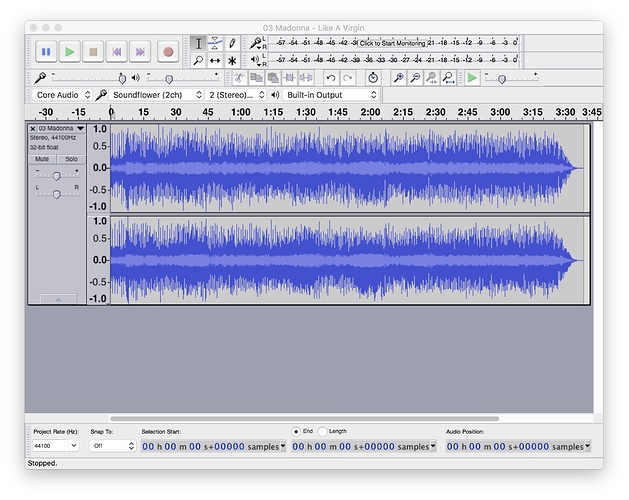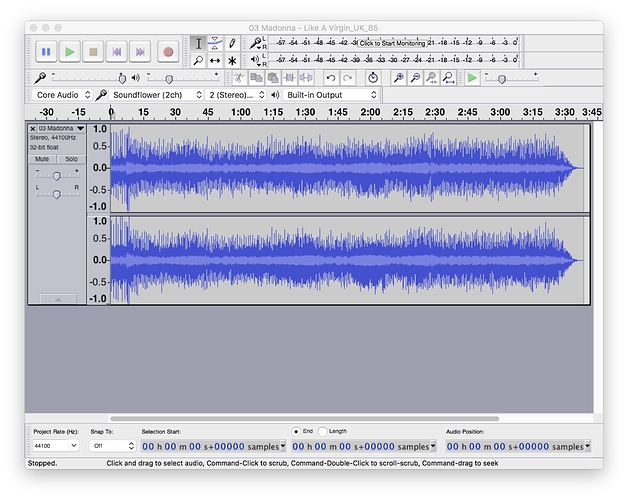Also, the Madonna “Like A Virgin” 192k / 44.1k discrepancy is addressed here. How long has this been up?
I just noticed a post by MQA of Facebook. Listening to the LZ now, undecoded but it sounds damn good.
See latest news on FCC rewriting the rules on Net Neutrality. Bandwidth should not be a problem but big business is going to make it a problem very soon. #SAD
Would you like to expand on this?
Yes, addressed with sophistry.
Bob appears to be cherry picking the 2001 brick wall limited remaster of “Like A Virgin.” When he displays the time domain graph of multiple clipped peaks, note the language he uses: “the same moment on a CD (which measures 8.5dB louder).” He says, “a CD,” not “the CD.”
I have the 1984 original mastering on several CDs, both US and foreign pressings. I also have the 1985 European mastering, which includes “Get Into the Groove,” on a Nimbus UK pressed CD. Neither of those masterings exhibit the significant clipping on the title track that Bob depicts.
Furthermore, both CD masterings of the title track have good dynamic range, measuring DR14 and DR16, respectively. The 24/192 transfer – from which the MQA release was derived – does not measure better in dynamic range. Only the aforementioned 2001 brick walled remaster measures about 10 dB worse in dynamic range and serves as Bob’s red herring.
http://dr.loudness-war.info/album/list?artist=madonna&album=like+a+virgin
AJ
Clearly Bob and MQA Ltd are deceiving us with all tha access to the studios, technicians, historical technical data, artists, copyright owners et al…
Ahh well…
It is great you can tell them apart. My hit rate is about 60%. The point however was about similar sounding files but with smaller sizes making MQA advantageous with regards to infrastructure, that bit of the process many of us are blind to.
I’ll concede there is a possibility that my DAC, amp, headphones, and/or ears may not be good enough to tell the difference between Hi-Res PCM and MQA…that would explain why you can hear it. But, how can you be certain the Hi-Res PCM version is a more accurate representation of the “original performance”? What is the accuracy that matters: bit for bit digital reproduction of a digital master or the way the analog sound is reproduced?
What DR rating is the 24/192 transfer used in the MQA release?
Yes, Hi-Res PCM at 24/352.8 or 384k (DXD) is the reference standard (many still use 24/176.4k or 192k) for professional recording and archiving. This is the closest one can get to the original performance as far as PCM is concerned, of course there’s another format called DSD… MQA is a final mixed down from Hi-Res PCM master (stereo); lossy compressed and packed into small files for easy distribution and streaming.
If one take away MQA and listen directly from Hi-Res PCM master, then you will immediate notice the difference. In a high end system it can be quite revealing. My argument is not about which ‘sound’ better but I’m more concern that MQA actually ‘coloured’ the original performance, a kind of ‘beautification’ to the original recording. As an audiophile who love music, I believe the original recording should be as transparent as possible, simply put in layman term; capture the original performance faithfully.
You can check quite easily. In my previous post, I included a link to all “Like A Virgin” entries in the DR Database. The 24/192 transfer is there.
AJ
Recording engineers who know say MQA captures the original recording session more faithfully; i.e., it’s better than “regular” PCM or DSD.
I don’t get why people can’t comprehend that high-rate PCM or DSD might actually be flawed and that there might be something better!
This is incorrect, MQA is derived from Hi-Res PCM master; the final mixed down to stereo Hi-Res PCM (WAV) is converted to MQA’s lossy compression small enough for easy distribution and streaming. All mastering from A/D to pre and post editing (DSP) in professional recording console are done strictly in Hi-Res PCM format. Undecode MQA cannot survive in a DSP environment such as pre and post editing process, it will simply render it undecode in the consumer’s MQA DAC end-point.
If you suggested that Hi-Res PCM is flawed, the end result will still apply to MQA.
This is incorrect. If you read the MQA was taken from a new (Hi Res) transfer from the Analog tape that was deemed the earliest Master recording.
This transfer was made for the purpose of MQA. All this Lossy talk is also misleading. Here we go again.
MQA fixes the problems inherent in the Hi Res Transfer.
This only applied to analog masters directly convert to MQA without any form pre and post editing. However, if pre and post editing are required it has to first A/D to Hi-Res PCM do all the necessary editing and final mixed down to Hi-Res PCM in stereo, then convert to MQA. This also applied to DSD too.
Most of recording done in late 80’s onwards are mostly digital masters and only hand full small labels still record in pure analog master.
And MQA Ltd are not aware of all this?
“At MQA, we are working back through archives, on the lookout for the definitive masters that capture the moment when the producer or artist agreed on the sound, whether in the recording or mixing or mastering studio.”
What MQA claims to do is make corrections for the ADC and DAC’s used for playback. As such PCM is perfect, or as good as you are likely to get. What is imperfect is our ability to recover the PCM encoded information accurately using more conventional DAC’s. The MQA process claims to do this as part of what it does. It is important to remember that MQA is a mash up of different processes offering different benefits to various parts of the industry. As such MQA’s only remit to us is to match the very best PCM playback systems. If it can get close on much smaller cheaper domestic DAC’s then it has done all that it can reasonably promise for end users.
Come to think about this, it reminded me the days when SACD was launched more than a decade ago, most of recording done on SACDs are either source from analog masters or recording studio has to purchase a new DSD master just to do pure DSD recording. DSD itself is difficult to do editing and requires special software tools to do just that. Hi-Res PCM to DSD transfers on SACD do exist but not many.
I think MQA is doing all over again just like Sony has done before. Whether it will succeed only time can tell.
No, a great many SACDs are PCM to DSD transfers.
AJ
Most of my SACD collections over the years mainly Classical and Jazz are done on pure DSD masters or source from early analog master. One can easily identify through leaflets at the back of SACD; ‘Pure DSD Master’ or ‘Analog to DSD Master’. I do have a couples of Pop music which were mastered in Hi-Res PCM but converted to DSD for SACD.

